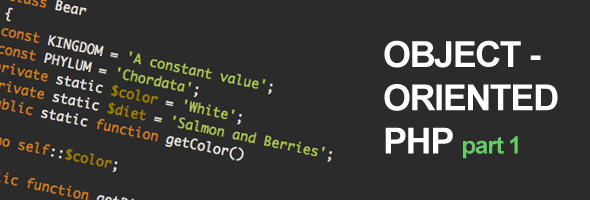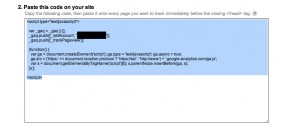I thought it would be fun to post random videos and things I find interesting about machines on this blog every weekend. This one is pretty cool. I think lego and rubiks cubes are two of the best inventions ever and putting them together is even better. So here’s my first “weekend special”, it’s a video I came across on Youtube.
Year: 2011
The Scope Resolution Operator (::) explained
I remember when I first came across the mysterious double-colon (::), also known as the Scope Resolution Operator. I was experimenting with a php library I hadn’t written, but was asked to extend, and at the time I had no idea what classes were, how they worked, or how they helped.
To try and figure out what the double-colon did I remember I peppered Google search with questions like, “What is the :: ?” or “what does the :: symbol mean?” Those searches proved useless. At the time php5 was still very new and most PHP coders were writing procedural code rather than object-oriented code.
Now that I use object-oriented design every day I thought I would explain what the double colon :: means, just in case there are any new PHP programmers, like I was, and are confused by the mysterious double colon.
When and how to use the double-colon:
You use the double-colon to access static methods from a class. To get the color of the bear, from the example class I wrote about here, you would write the following.
Bear::getColor();Code language: CSS (css)I will break the above line of code into its three parts.
1. Bear – First you write the name of the class you are referring to. In this case Bear.
2. :: – Then you use the double-colon because the method is declared as static.
3. getColor(); – Then you write the name of the function you are calling that exists within that class.
And that’s the basic use of the double-colon to call a method from within a class.
The double-colon is simply a way of referencing the class object and accessing the static methods (functions) and constants within that class. If you are new to this I just said a lot. I explain these things briefly here.
PHP Classes briefly explained
What is a Class
A class is also known as an object. To better understand the concept of an object, think of it as you would a material object like a bear. Let’s pretend that we are going to have to make a bear using a class. To start you would give the animal a name. In this case, class Bear. Then you would need to add characteristics. Like the animal’s color and weight. These would be the variables declared at the beginning of the class. You are declaring them as variables as it is possible that these characteristics might change with different bears. You may have the variable $color = ‘white’ or $weight= ‘500kg’. You may also have constants, these don’t change. A constant might be something that classifies a bear as a bear, for example some Scientific classifications would be KINGDOM = ‘Animalia’, or PHYLUM = ‘Chordata’. These things are common to all bears and do not change. You would also have methods. Methods are functions that either call data about the bear or calculate something for the bear and return the values back to the caller. You may have the function getColor(), to get the color of the bear. Or getKindom() to get the kindom of the bear.
When you write a class you have the option of declaring a variable or method public or private. A public method or variable is accessible by all. A private method or variable is only accessible to methods and variables within the class. A good rule of thumb in writing classes is to try to avoid making variables public. You may need to edit your classes over the course of time and the variable may change, this would affect any application that would have been referring to the variable had it been public. Rather, try to refer to variables only using methods. This ensures that even if you change how or where you store the information, the method to get the information could be rewritten to handle the changes so the applications referring to your class would continue to work and know no different.
To create a class simply write:
class Bear { #Any code goes here }Code language: PHP (php)
The following is an example of a simple class. A class can include variables (methods), functions, constants etc.
class Bear
{
const KINGDOM = 'A constant value';
const PHYLUM = 'Chordata';
private static $color = 'White';
private static $diet = 'Salmon and Berries';
public static function getColor()
{
echo self::$color;
}
public function getDiet()
{
echo self::$diet;
}
}Code language: PHP (php)Important Notes:
Usually it is good practice to save each class in individual files. In this case I would save the above class in the file Bear.class.php. I like to include .class within the file name. It is not necessary but it makes it much easier to know which files are classes.
There are a lot more to using Objects than what I showed you in the simple example above. But that is all you really need to know to get started using static functions and classes.
In the future I will create more tutorials showing you how to extend objects and to call them. And explain what new ClassName(); means and how the operator -> works.

I like Dropbox. I use it all the time to share files across machines and work on group projects. However, I don’t like how Dropbox duplicates files as and saves them as conflicted copies. It’s not something that I need or use. I just delete those “conflicted” files. 99.99% of the time the conflicted files are not conflicted, Dropbox is just over zealous. Also I use .git to handle my file pushes so I know right away if files have changed. I don’t need Dropbox doing this for me.
I work on a Mac so here is something I run in my terminal to quickly remove those annoying conflicted files.
$ cd dropbox
$ find . -type f -name "* conflicted *" -exec rm -f {} \;
Today I had to set the PHP script execution time directly from within the php file. Here’s what I did.
Add the following code to your file. You can change the seconds to what you need. It is important to be careful using this on a live server. If you allow a script to run too long you could hog all your servers resources and bog the site way down. 5 minutes is a lifetime in server time and it might be longer than you need.
ini_set('max_execution_time', 300); //300 seconds = 5 minutes
My first post for this blog was about inspiration and why I believed it was necessary for success in business. The other day I was watching some videos of Steve Jobs on You Tube talking about business success. In the interview he stated that passion was the ingredient that sustained successful people until they had success.
Achieving success is hard. Ask anyone who has played sport competitively, or tried to change the minds of people in a team or politics. It takes a lot of work and a lot of perseverance, and often times, in business it seems like it takes more perseverance simply because the goal is new and untried.
So passion is not a luxury anymore if you are an entrepreneur and you want to succeed. I’ve often believed that its good to love what you do, but haven’t really taken much time to think about the implications of loving what you do. It means that when the hurdles and challenges come, you have more than will-power motivating you to continue. It means that when your big sale fell through and you can’t pay yourself for a second time in two months you have more than will-power motivating you to continue. It means that when you can’t see the crest of the hill but believe in what you are doing you have more than will-power motivating you to continue.
“I’m convinced that about half of what separates the successful entrepreneurs from the non-successful ones is pure perseverance.” Steve Jobs
I don’t know what challenges you might be facing in your business, but I hope that you will persevere. If anyone is reading this and has a story about perseverance please leave it in the comments below. I would love to hear it.
If you are interested, here are some great Steve Jobs quotes.
Recently our servers went down. The error we were getting was “Too many connections”. This meant that we needed to increase the limit on the number of available connections within our mysql config file. The setting is called
max_connections
Before you go upping the number of max user connections there are two things to consider.
1. Is your code opening and closing the connections efficiently?
According to the mysql “using mysql_close() isn’t usually necessary, as non-persistent open links are automatically closed at the end of the script’s execution.” However, there are rare occasions where the connections do not close properly, so it is always a good rule of thumb to include mysql_close() at the end of your scripts.
Another mistake that can occur is that you may be unintentionally opening a new connection for each query, rather than opening one connection and then closing it once all your queries are completed. This will definitely increase the number of user connections.
Also, using persistent connections are generally frowned upon these days. For php using mysql_connect has actually proven to be more efficient.
2. Do you have enough memory (RAM) available to handle your increased connections.
Once you know your code is clean and you are still running out of available user connections the next step will be to increase your number of max_connections on your mysql config file.
It is important to calculate your available memory before upping your connection limit however, other wise you will encounter this error:
Connect Error (1135) Can't create a new thread (errno 12); if you are not out of available memory, you can consult the manual for a possible OS-dependent bug
This error is simply telling you that you are using too much memory. To avoid this error when upping your connection number use the following formula to calculate your number of available connections.
Key_buffer_size + ((read_buffer_size + sort_buffer_size)*max_connections) = memory needed
If you know your server’s ram, calculating the number of max_connections is straight forward.
I hope this helps you if you are encountering this problem
Note: Your current settings for Key_buffer_size, read_buffer_size, sort_buffer_size and max_connections can all be found in your mysql config file.
Recently we migrated our server to Media Temple’s grid servers. I had heard good things about Media Temple from others before making the decision to migrate, however while migrating we started to encounter challenges that I was not forewarned about. So here are 3 things that I wish we had known before moving, I hope they will help you avoid the pitfalls we encountered.
1. Mysql Views are not allowed
We discovered this while attempting to install our database on our new MediaTemple database. I sent a support request about this, they replied that they are planning on allowing views in the future, but don’t presently. While most web applications do not use Mysql views ours did. As a result I spent needless hours rewriting code to work without views. It was frustrating to say the least.
2. Maximum 500 emails per hour and 60/min
Here’s another small fact to know before deciding to move over to the grid server. There is a limit of 500 emails per hour. 500 emails an hour sounds like plenty. It’s not. Our application communicates to our users via email, sending updates and notifications constantly. We now pay for a 3rd-party API to send emails to our users. This is unnecessary and MediaTemple should really look at changing this.
3. No static outbound IP Address
This proved to be the biggest frustration of them all, especially because I asked one of MediaTemple’s support people about this before migrating and they ensured me that they had offered static outbound IP addresses. They do not. MediaTemple will give you a static IP address for all incoming requests. However, it will not give you a static IP address for outgoing requests. This was a big deal for us because we were using a secure API that required a single static outgoing IP Address. However, MediaTemple was unable to provide us with one. When I asked if they would be able to NAT the outgoing IP Address range to one address, the response was “Uhhhhhh?? Let me ask our server team”. Not very reassuring. They eventually responded with “no”, but without any reason why. We did come up with a work-around solution, but it is not ideal to say the least.
Despite these unpleasant surprises there are definitely some strong pros to MediaTemple. Its grid server uses a very eloquent node sharing system. This allows server resources to be freed up and reallocated where needed. Also they offer mysql containers to ensure dedicated ram is always available for your database requests for an additional fee. There support isn’t the greatest especially when compared to some of the hosting companies I also use, like LiquidWeb.
Overall I would recommend MediaTemple’s Grid Server, just know what you are getting into.
MVC architecture explained briefly.
Inevitably every programmer is going to encounter MVC architecture. MVC or model-view-controller is a pattern used by applications that divides the application into 3 parts. At first glance MVC can look more complicated than it is. Let’s look at the three parts.
Model – The model handles the data and cares about where the data is coming from. Typically it involves connecting to a database, but it could collect data by reading a file. The model only knows that data is there, it does not know what the data is or what you are doing with it.
View – The view cares about how to display the data. It doesn’t care where the data comes from or what the data means only that it is to display it.
Controller – The controller is the bridge between the Model and View it interprets the data and handles any calculations. It doesn’t care how the data is stored or how to display it. It does care what the data means.
The advantage of MVC is that you can change things in one part of the application without “breaking” the other parts. For example, you could change where the data comes from in the Model. Because the View and the Controller never knew where the data came from they are not effected by the change. Likewise, you could change how you want the data displayed in the View but neither the Model or the Controller is effected.
For example. Let say we are viewing Facebook. What you see is the view. When loading a FaceBook page the view tells the controller that it needs data, the controller gets the correct data from the Model and sends it back to the View. The View then displays that data. The Model and the Controller don’t care that the data is being displayed on a computer or on an iPhone application.
So it’s really not a very complicated architecture structure.
Step 1. Sign up for Google Analytics
Once you are logged into Google Analytics:
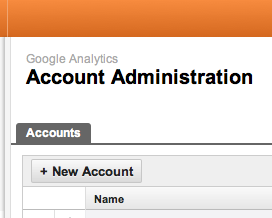
- Click + New Account.
- On the Create New Accountpage, under General Information, enter your account name and the URL for your web property. You may see that the Account Name field has a default value of the URL for your web property. You can change that value to something more meaningful.
- Under Data Sharing Settings, select the data-sharing options you want.
- Under User Agreement, select your country or territory from the menu, read the terms of service, then select the check box for Yes, I agree to the above terms and conditions
- Click Create Account.
Step 3. After creating your account you will see your tracking code. Copy your analytics code for later use.
Step 4. Add code to WordPress
I will be using the functions method.
- Login to your WordPress admin.
- Expand the Appearance tab and click Editor on the menu.
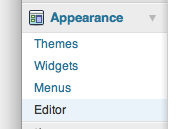
- In the Edit Themes page you will see a list of files on your right. Click functions.php
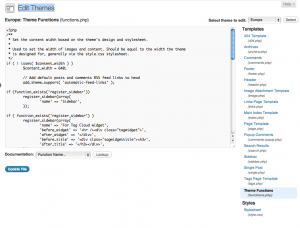
- Now on the top of the functions.php file below the comments add this code. Remember to paste your Google Analytics code from Step 3 here.
add_action('wp_footer', 'add_googleanalytics');
function add_googleanalytics() { ?>
// Paste your Google Analytics code from Step 3 here
<? }
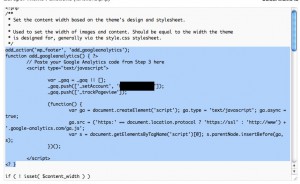
Now you have installed Google Analytics to your WordPress site. It takes 24 hours for Google Analytics to start showing your results. Log into your Google Analytics account in the next couple of days and you will see your traffic stats.


